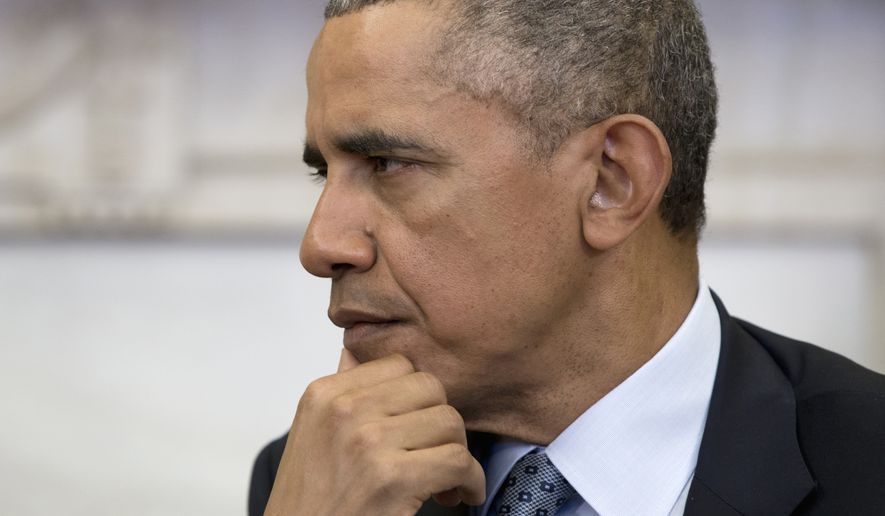The federal government will be flirting with $30 trillion in debt within a decade, the Congressional Budget Office reported Monday, blaming an aging population, new spending and tax cuts approved on Capitol Hill, and the growing burden from Obamacare for erasing the progress Washington had made over the past few years.
Analysts said Obamacare will chase more workers out of the labor force over the next five years, adding pressure to an economy still struggling to spring to life more than seven years into the Obama recovery.
The Affordable Care Act itself is still struggling to attract a customer base, the CBO said, lowering its estimate for the number of people who will sign up for the exchanges from 21 million to 13 million — a drop of nearly 40 percent in projections. Customers collecting taxpayer subsidies this year will be 11 million, down from the 15 million the CBO projected a year ago.
The grim news comes with less than a year left for President Obama to put the law on firmer footing as he seeks to head off what is likely to be a last effort at repealing the act after November’s elections.
The economic front is somewhat brighter for Mr. Obama, who seven years into the recovery will finally see significant sustained growth of 2.5 percent this year and 2.6 percent next year, the CBO said.
That will be followed by a cooling off, with growth dropping below 2 percent in 2019 and 2020. The economic gains will continue to go disproportionately to the wealthy, helping boost income tax revenue but limiting payroll taxes, which will put even more pressure on the entitlement programs that are driving up deficits.
PHOTOS: See Obama's biggest White House fails
The biggest fiscal dent, however, was made late last year when Mr. Obama and the Republican-run Congress struck a deal. The president won significant spending hikes, and Republicans insisted on a new round of special tax breaks that, combined, reversed years of progress and added nearly $750 billion to projected deficits over the next decade.
“After six consecutive years in which the deficit has declined relative to the size of the economy, this year’s deficit — at 2.9 percent of gross domestic product (GDP) — is anticipated to increase for the first time since it peaked at 9.8 percent in 2009,” the CBO said.
Deficits will continue to rise over the next 10 years, topping $1 trillion again in 2022 and reaching $1.4 trillion in 2026, the analysts said.
The accumulation of those deficits will deepen the gross public debt from $18.1 trillion at the end of 2015 to $29.3 trillion in 2026. By contrast, the debt stood at $10.6 trillion when Mr. Obama took office in 2009.
Looking decades into the future, the picture only gets worse, the CBO said.
“Beyond the 10-year period, if current laws remained in place, the pressures that had contributed to rising deficits during the baseline period would accelerate and push debt up even more sharply. Three decades from now, for instance, debt held by the public is projected to equal 155 percent of GDP, a higher percentage than any previously recorded in the United States,” the analysts concluded.
PHOTOS: 15 most expensive celebrity divorces
The grim picture has sparked fear among budget watchdogs and on Capitol Hill — though Democrats and Republicans remain at odds over the best way to tackle the problem. Republicans favor tax cuts to spur the economy, and Democrats call for tax increases and government spending to invest in growth.
In the short term, the tax cuts have deepened the deficit, the CBO said. But so have the tax increases under Mr. Obama’s policies, including the Affordable Care Act’s levy on high-income taxpayers.
“The ACA’s largest effect on the labor market — especially as overall employment conditions improve — will come from provisions of the act that raise effective marginal tax rates on earnings, thereby reducing how much some people choose to work,” the CBO said. “The act also directly imposes higher taxes on some people’s labor income. Because both effects on labor supply will grow over the next few years, CBO projects, they will subtract from economic growth over that period.”
On the enrollment side, the news is also troubling. The exchanges, which are the online marketplaces where those without coverage can buy plans, are struggling to meet goals.
The CBO said enrollment this year is now likely to be only 13 million customers — down from the 21 million projected a year ago. Of the enrollees, just 11 million will get government subsidies — down from the 15 million the CBO previously projected.
The updated projections were released as part of the CBO’s 2016 budget outlook and confirm the administration’s own dim estimates of how many people would take advantage of the health care exchanges, which are at the heart of the Affordable Care Act.
The Obama administration already dropped its own projections of enrollment, saying the pool of available customers was smaller than it thought, so there are simply fewer people to be nudged into signing up.
• Stephen Dinan can be reached at sdinan@washingtontimes.com.




Please read our comment policy before commenting.